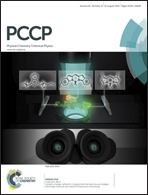Reaction dynamics of the 4-methylphenyl radical (C6H4CH3; p-tolyl) with isoprene (C5H8) – formation of dimethyldihydronaphthalenes†
Abstract
We probed the reaction of the 4-methylphenyl radical with isoprene under single collision conditions at a collision energy of 58 kJ mol−1 by exploiting the crossed molecular beam technique. Supported by the electronic structure calculations, the reaction was found to initially lead to a van-der-Waals complex without any barrier which can then isomerize by addition of the 4-methylphenyl radical to any one of the four carbon atoms of the 1,3-butadiene moiety of isoprene. The initial addition products isomerize with formal addition products preferentially to C1 and C4 carbon atoms of the isoprene. These structures further isomerize via hydrogen migration and cyclization; the reaction is terminated by a hydrogen atom elimination from the 4-methylphenyl moiety via tight exit transition states leading to two dimethyl-dihydronaphthalene isomers as the dominating products. This study presents one of the very first bimolecular reactions of the 4-methylphenyl radical with unsaturated hydrocarbons and opens a path for the investigation of this reaction class in future experiments.


 Please wait while we load your content...
Please wait while we load your content...